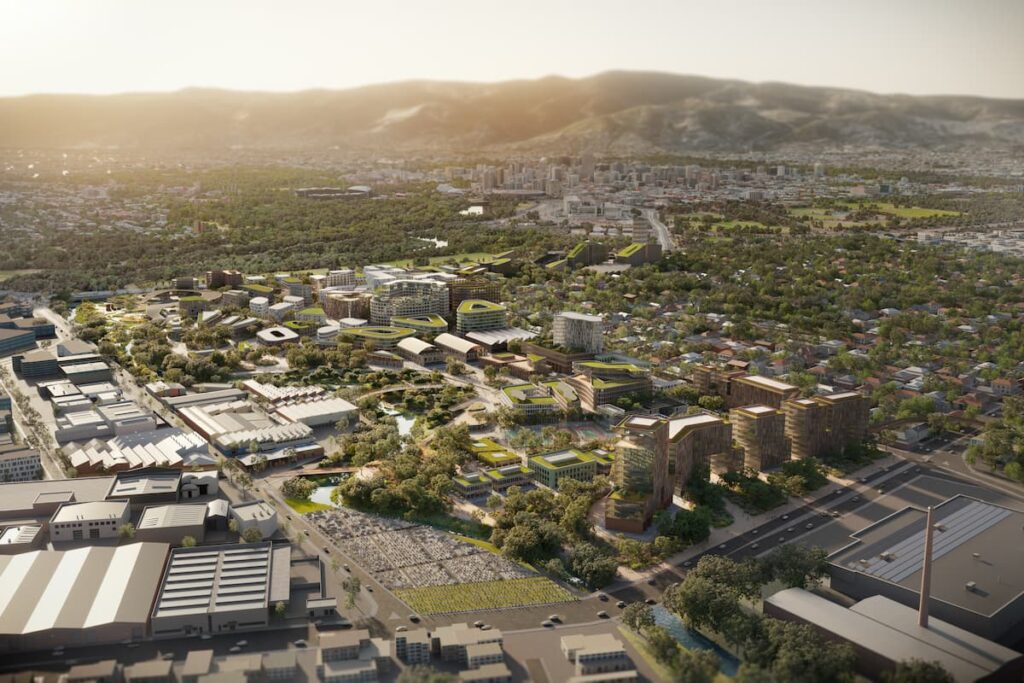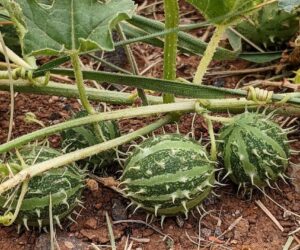Architectus Reveals Vision to Redefine and Rewild Adelaide’s Thebarton
Architectus has unveiled its vision for Adelaide’s Thebarton, reimagined as a Country-centred landscape and riverside dotted with buildings and spaces for health and innovation, mixed housing, commercial activity, and community interaction.
As demand for housing and jobs with proximity to transport, services, and amenities grows, Architectus has identified the inner-western suburb of Thebarton as ripe for renewal, with its strategic location between emerging health and innovation developments and a rich, diverse natural environment.
The visionary concepts are the outcome of the practice’s 15th Design Charrette, an annual event that brings together designers from various disciplines, locations, and experience levels to take on a unique design challenge, exploring powerful new ideas for renewing Australia’s cities.
Designing with Country and the environment were identified as key priorities, as the teams delved into the challenges and opportunities facing Thebarton, a former light industrial corridor at the edge of Adelaide.
The First Nations narrative was inspired by the vital role of the Karrawirraparri (Torrens River), which served as a corridor for Kaurna peoples moving from the foothills to the sea at the change of seasons. This journey is represented through the varying scale and form of the buildings, material palette, pathways and landscaping.
“With an extensive infrastructure pipeline, employment diversity, relative affordability and strong migration, Adelaide still has growth to unfold. Combined with Australia’s increasing population, it has the perfect mix of fundamentals to become a capital city for the 22nd century. And there are great urban regeneration opportunities defined by the city’s natural landscape, including in places like Thebarton,” said Architectus CEO, Ray Brown.
“To imagine Thebarton’s future, we had to first grapple with its past and the lasting impacts of colonisation on Adelaide. Our vision redefines the suburb through the lens of reconciliation and Designing with Country.”
“We focused on repairing the river and allowing the landscape to ‘rewild’ the suburb, unlocking the potential for a new kind of parkland and habitat. The scheme offers diversity of form, buildings, homes, environment, and all the spaces in between bring an authenticity – creating a sense of place and community in a new setting with a range of uses.”
The practice’s Charrette concept identifies three key areas of opportunity in Thebarton, imagining a new approach to urban renewal, a strategic location for allied health and innovation; and a place where the river can be returned to its natural state. Opportunities to attract and support innovation industries, disruptive technologies, and regional growth were also explored with the view to regenerating the area sustainably and building resilience for the future.
By the numbers
- Total site area – 50 ha (504,800 m2)
- Mixed residential – 354,000 m2 GFA with 30% affordable housing
- Commercial – 72,200 m2 GFA
- Innovation/Tech/Startups – 5,500 m2 GFA
- Creative industry – 13,500 m2 GFA (including adaptive re-use of several existing and heritage buildings)
- Food & Beverage – 8,800 m2 GFA
- Retail – 3,400 m2 GFA
- Three hotels – Total 25,000 m2 GFA; Family Hotel, 490 rooms; Budget-friendly Hotel, 154 rooms; and Luxury Hotel, 73 rooms. Hotels connect with the pedestrian bridge to improve walkability to, and from recreation, events and cultural venues.
- Events and culture spaces 20,000 m2 GFA
- Community Hub – 5,000 m2 GFA (adaptive re-use of an existing heritage building)
- Health and allied services 38,000 m2 GFA
- Regenerated river parkland – 83,000 m2 GFA
- New urban park – 69,000 m2 GFA
More diverse housing
Adelaide’s CBD is predominantly surrounded by low-density and low-rise suburbs, presenting a challenge for the design teams to match the density of the CBD and urban renewal sites in neighbouring Bowden. But that also presented an opportunity to rebalance the urban form in the context of nature, breaking away from both the Adelaide grid and the traditional street block to design new models that work with Country.
Architectus also acknowledged the demand for a range of housing models to suit diverse needs – places that are well located and adaptable over time to enable communities to form and thrive. The teams created 3,200 dwellings across the site, with 30% allocated for key workers and social and affordable housing. The mid-size residential blocks – generally four to eight levels – have been clustered around open space, with access to active transport links connecting these spaces and activity areas. These groupings respond to the topography of the river and the overland flow and flooding patterns, to repair the landscape and connect with Country while providing biophilic places to live.
Allied health services and innovation
The proposed precinct strengthens Adelaide’s future economy, with spaces not only for new industries, healthcare, start-ups but also defence innovation.
Port Road in Thebarton has been identified as a prime location for a mixed-use health and well-being precinct, with the proposed new Women’s and Children’s Hospital and Adelaide biomedical precinct adjacent to the site. Under this concept, allied health services such as day surgeries and housing for essential workers are incorporated, along with amenities including a new supermarket and places to eat and drink.
Repairing the river
In returning the river to its natural state, the concept proposes restoring the river’s edge by renewing habitat and engaging with the Karrawirra Parri. It introduces an Amphitheatre with an eel-like arbour structure for shelter, a new pedestrian and cycling bridge to Bowden, and a new river walk, plus a range of ways to enhance the biodiversity and habitat of the area.
The 2023 Design Charrette included the following collaborators and speakers: First Nations cultural consultant Karl Winda Telfer, integrated design specialist Daniel Bennett from Aurecon and Professor Veronica Soebarto from the School of Architecture and Built Environment at The University of Adelaide.
The annual program and events reflect the practice’s commitment to design culture, exploration, and collaboration.
For more about previous concepts, visit the Charrette 14 and Charette 13 on the Architectus website.







